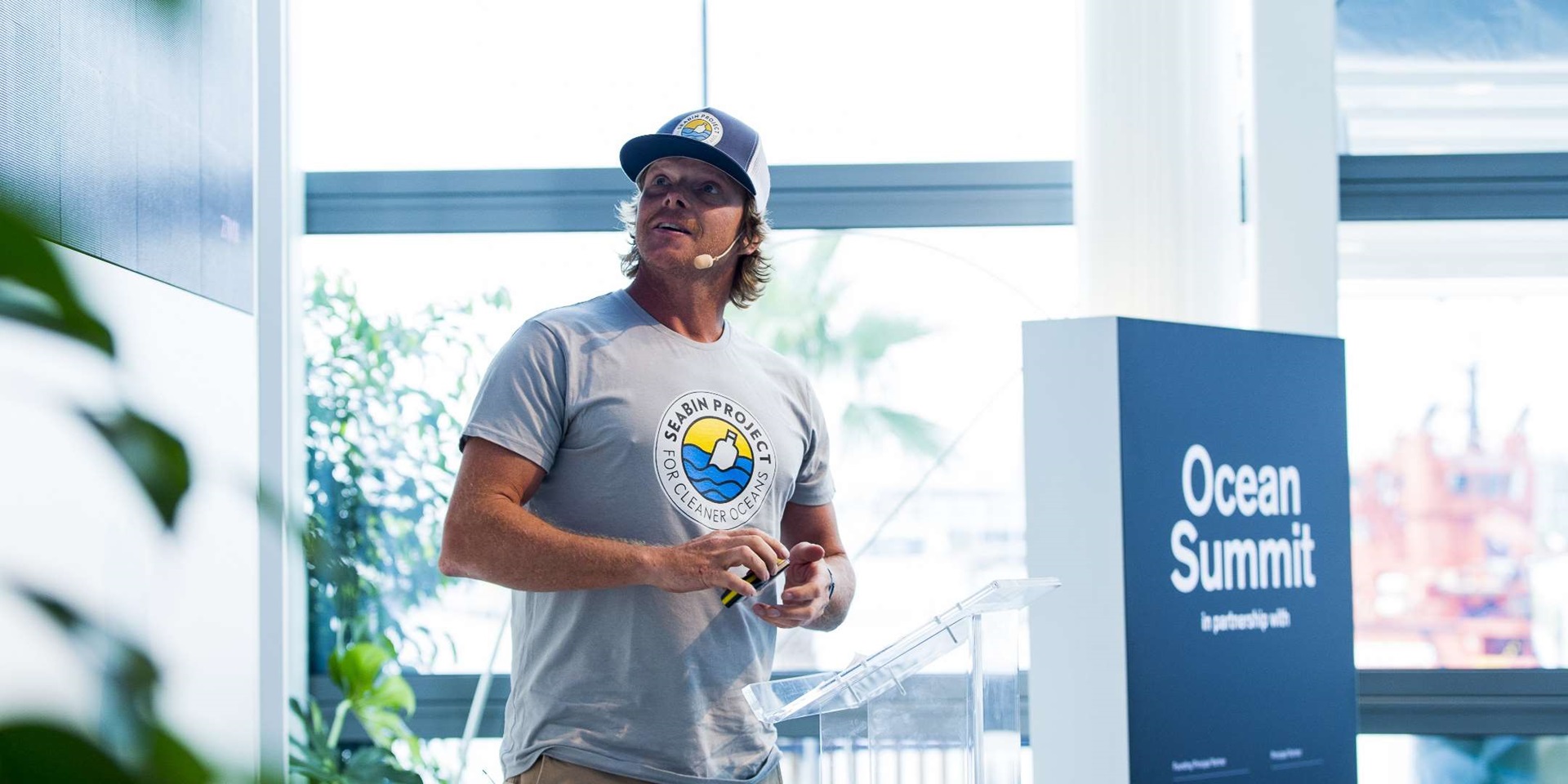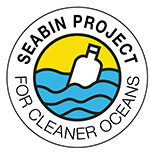

The Seabin Project develops upstream solutions for waterways adjacent to high population areas, such as marinas, ports and public waterways. This is a front-line approach: if you can capture the debris deposited into the water at its most common source (near land), less garbage will work its way out into the oceans. Image: Seabin Project.
Bin it to win it
Once upon a time, two surfers got sick of swimming in garbage. Unlike most of us, they decided to do something about it. In 2015, Andrew Turton and Pete Ceglinski quit their jobs and sourced seed funding from Shark Mitigation Systems to design a prototype ocean garbage collecting ‘Seabin’. This began a journey of research and product development that would take them around the world. Today, they are finally bringing their invention home to Australia.
The Seabin Project develops upstream solutions for waterways adjacent to high population areas, such as marinas, ports and public waterways. This is a front-line approach: if you can capture the debris deposited into the water at its most common source (near land), less garbage will work its way out into the oceans.

The Seabin Project says ‘If we can have a rubbish bin on land then why not have one in the water…’. Every year more plastic finds its way into the ocean and washes up on shore. Image: Don Mammoser/Shutterstock.com.
Turning the plastic tide
Plastic pollution in the oceans is a real problem. It is rated in the top three dangers to a continuing healthy ocean (along with ocean acidification and ocean warming). Eight million tonnes of waste – most of it plastic – is added to the oceans each year (Jambeck et al 2015).
Mats of macro (big) and micro (small) plastics coagulate in naturally occurring ocean currents—or gyres, forming floating ocean plastic structures on the surface of the oceans, like the Great Pacific Garbage Patch.
Microplastics can also find their way into the stomachs of marine mammals, birds, and even (as nanoplastics) in plankton. Macro plastics have been found suspended in the water column at depth by divers. They are in our clothes, our food, our skin, our water. Plastics are everywhere.
In a plankton sample I collected yesterday on 5th December, another 6 mm long arrow worm is seen with a blue plastic microfibre in its gut @UNEP #CleanSeas @Zeiss_micro pic.twitter.com/ZNHaNwappg
— Dr Richard Kirby (@PlanktonPundit) December 6, 2017
This morning, in honour of World Oceans Day, the Seabin Project deployed the Seabin V in the basin adjacent to the Australian National Maritime Museum. While the Seabin team are Australian, most of their work to date has been overseas. Their factory was in Mallorca, Spain (not a horrible location for surfers) and ports and marinas across the Mediterranean have ordered the bins for use in their facilities. But now that they’ve come home, it is time to see how it operates in Sydney Harbour:
‘The team and I at Seabin Group are extremely excited to have Australia’s first Seabin installation and demonstration taking place at the National Maritime Museum on World Oceans Day this coming Friday 8th June. We are also honoured to have partnered with the Australian National Maritime Museum for this event in Darling Harbour and hope to build upon this opportunity with ANMM to create a dynamic and impactful relationship in the very near future for the health of our waterways and our oceans.’ – Pete Ceglinski, CEO and Co-Founder.
The Seabin V is an ocean garbage bin that works like a large pool skimmer. It is powered from shore—requiring access to electricity—and uses a 110 or 220 V motor to pump water to create a vortex, sucking debris out of the water and into a catch-bag within the bin, pushing the cleaned water back out.
It is also equipped with oil absorbent pads that clean surface water of petroleum-based oils and detergents. The catch-bag was recently re-engineered to collect micro fibres. The Seabin can capture an astounding 90,000 shopping bags per year. Note: Coles and Woolworths have announced plans to ban single-use plastic bags nationwide by the end of the month.

The daily catch of a current Seabin. The Seabin installed in our Basin collected 10kg of waste in 12 hours. Image: Seabin Project.
In low-to-no wind conditions, it can pull in debris from a two to six-metre radius. However, it cannot attract garbage from a distance, so a best practice solution is to place Seabins at strategic places in heavily-trafficked waterways to maximize collection.
While it also cannot collect large items (like the 20 L container above) it does create enough flow to push larger debris up against the bin, allowing for easier hand-collection. The catch-bag can be removed, cleaned and replaced, allowing for 365 days of operation.
Like all start-ups, it is a work in progress. While the bin is 100 percent recyclable, the Seabin team are still working to develop a recycled material catch-bag, and have trialled using solar panels as a zero-carbon power option. The Seabin Project know their product isn’t perfect, but it is a great step in the right direction. As they say, ‘our vision for a better future is to not have a need for Seabins’.
Trialling a Seabin at the museum
The Seabin is on site today thanks to our Fleet staff, Lee Graham and Jeff Hodgson, who kick-started the collaboration between the museum and the Seabin Project. Fleet are the museum’s staff with the most direct (and daily) access to the water and see just how much floating rubbish there is in Sydney Harbour.

Just over a year ago, Fleet designed and deployed a set of two Sea Waste Action Bins (S.W.A.B.), or wheelie bins with windows. The bins are 240 litres each & equipped with drainage holes, 3mm tough poly-carbonate sheet windows, fastened with stainless steel. Our volunteers hand-collect floating rubbish from the water with sieves and deposit it in the bins. Four bins loads equals about one cubic metre. Seven cubic metres were collected from outside the museum last year. Earlier this week, Fleet installed a simple boom collection device at a strategic wharf location (under the North Wharf) to assist with the collection of larger floating objects.
Be a ‘bindividual’
As the nation’s entrepot, Sydney Harbour is a perfect place to trial the Seabin in Australian waters. The Seabin is a practical, on the ground approach to reducing visible waste in public waterways, but the Seabin Project isn’t just about a floating water suction-powered garbage bin: their aim is to collaborate with corporations, governments and non-profits to develop and implement long-term solutions to ocean plastic pollution.

As proponents of a ‘whole solution strategy’, the Seabin Project engages with schools and communities to discuss how limiting our purchase and use of plastics reduces our plastic footprint and diminishes overall ocean waste. Image: Seabin Project.
As proponents of a ‘whole solution strategy’, they engage with schools and communities to discuss how limiting our purchase and use of plastics reduces our plastic footprint and diminishes overall ocean waste. The CSIRO national marine debris study recently concluded that the current person to coastline ocean plastic ratio is more than 1:5 (Hardesty et al 2016). If it all goes into the water, that’s at least five pieces of floating garbage per person.
On World Oceans Day, isn’t it in all of our best interest to do just a little more?
— Emily Jateff, Curator of Ocean Science and Technology
To see the Seabin in action, come down to the maritime museum wharves on 8 June. While you’re at it, check out the Australian National Maritime Museum’s newest exhibition James Cameron: Challenging the Deep for a glimpse at what lives in the deep ocean that we’re working to save for future generations.
With Thanks to our Partners


References
- Jambeck, JR, Geyer R, Wilcox C Seigler TR, Perryman M et al (2015) Plastic waste inputs from land into the ocean. Science 347, 768-771.
- Hardesty BD, Lawson TJ, van der Velde T, Lansdell M, Perkins G, Wilcox C (2016) Estimating quantities and sources of marine debris at a continental scale. Frontiers in Ecology and the Environment 15(1), 18-25.













